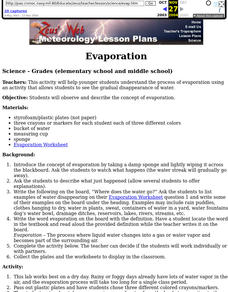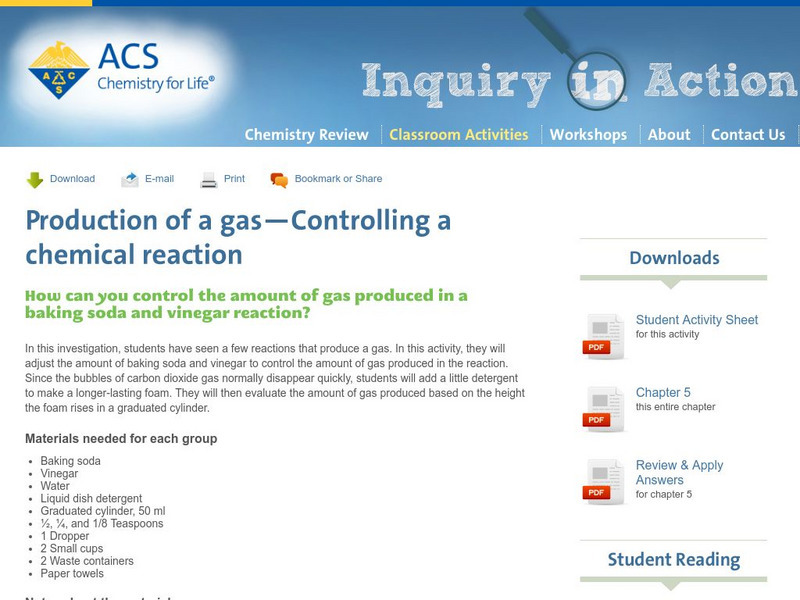Curated OER
Watershed Investigations
Young scholars find maps of the region to show rock formations and soil types and use GIS to compare radon levels. They describe three types of radioactive decay, interpret graphs, and follow steps to develop a nuclear bomb or energy.
Curated OER
It's Okay to Exhale: Photosynthesis and Cellular Respiration
Students will observe the differences between photosynthesis and cellular respiration. Then they observe the links due to climate changes and relate how climate change affects their lives.
Curated OER
Radiation In Our World
Students identify the different sources of radiation around us. In this physics lesson, students calculate their estimated radiation exposure per year. They research a current issue about radiation.
Curated OER
Our Food and Microorganisms
Young scholars answer questions about how microorganisms can affect our food supply and how they can be controlled. The first set of inquiry activities are directed by the teacher. Subsequent activities are based on students generating...
Curated OER
Evaporation
Pupils explain the process of evaporation using an activity that allows students to see the gradual disappearance of water.
Curated OER
Middle School Home Energy Audit
Seventh graders research the origins of local electrical power and compare costs and methods of generation with other areas of the country or world.
Curated OER
Teaching Modeling Water Quality
Learners explore the basics of interpreting RUSS temperature and oxygen profile data. They are introduced to the Geographic Information Systems (GIS), particularly with respect to interpreting maps.
Curated OER
Mixing Colors
Fifth graders perform experiments with color mixing and color changing. They observe the differences between physical and chemical changes and record their observations in journals.
Curated OER
The Penny Factory
Fourth graders identify the characteristics of a simple physical and chemical change. They describe objects by the properties of the materials from which they are made and separate or sort items using these properties. Students explain...
Curated OER
CO Buildup City
High schoolers conduct a controlled experiment. They collect data in an organized manner. Students analyze data to reach a conclusion and communicate findings. They explain how city size, temperature, and pollution is related to the air...
Curated OER
Creating a Disaster
Students construct a volcano model. In this earth science lesson, students determine the structure and build of their volcano. They explain the danger of volcanic eruptions.
Physics Aviary
Physics Aviary: Gas Lab
This lab is designed to have students examine the different relationships that exist for gases in a box.
Texas Instruments
Texas Instruments: Gas Lab
Students determine the molecular weight of a pure gas in a balloon by using gas laws and trapping the gas in a glass bottle. Students watch the instructor demonstrate the lab on day one. On day two and three they practice the lab. On day...
Texas Instruments
Texas Instruments: Molar Gas Lab
Students use stoichiometry to determine the mass of oxygen gas in a bottle. They may also check their answer against the amount of potassium chloride produced during the reaction.
Concord Consortium
Concord Consortium: Molecular View of a Gas
This simulation allows students to make observations about the structure and movement of particles in a gas.
Science Education Resource Center at Carleton College
Serc: Mini Lab: Investigating Gas Laws
In this activity, young scholars investigate two gas laws: Charles and Boyle's. They will determine the relationship between gases and certain variables (temperature, volume and pressure), then watch a demonstration and determine what...
Alabama Learning Exchange
Alex: Gas Laws
The teacher will perform a demonstration of imploding a coke can. We will then discuss Boyle's law. After this discussion, we will conduct the science in motion lab "Boyle's Law". Each lab group will load their graphical results into a...
Science Education Resource Center at Carleton College
Serc: Observing the Effect of Temperature on Change of State and Gas Pressure
This lab serves as a short introduction to both changes in state and air pressure/the gas laws. The students will heat a small amount of water in an aluminum can. They will then invert it in a bucket of cold water and crush the can using...
American Chemical Society
Inquiry in Action: Production of a Gas: Controlling a Chemical Reaction
Observe reactions that produce gases in this lab activity! Students observe chemical changes as they evaluate the amount of gas produced. This lab activity includes both student and teacher instruction sheets.
Physics Aviary
Physics Aviary: Thermal Speed Lab
This lab is designed to have students learn the factors affecting the RMS velocity for a sample of gas. The student will be able to set the temperature of the environment and the mass of the particles.
University of Nebraska
Do Chem Doing Chemistry Experiment Descriptions
You have to Scroll down to find them, but there are some good gas labs that relate to pressure that can be done.
Annenberg Foundation
Annenberg Learner: The Habitable Planet: Carbon Lab
An interactive lab simulation demonstrates the effects of increased carbon in the atmosphere and how that increase contributes to climate change. A data table for student records is available for download.
Physics Aviary
Physics Aviary: Maxwell Distribution Lab
This lab is designed to have students examine distribution of speeds for gases in a box.
Physics Aviary
Physics Aviary: Heat Transfer Lab
This lab is designed to have students examine the different factors that affect the rate of heat transfer through a barrier between two gases.
Other popular searches
- Got Gas Density Lab
- Ideal Gas Laws Lab
- Ideal Gas Law Lab
- Greenhouse Gas Lab
- Combined Gas Law Labs
- Gas Lab Alka Seltzer
- Gas Lab Alika Seltzer

















